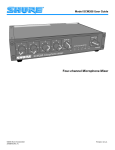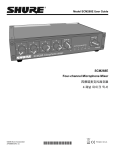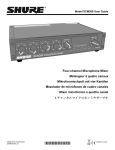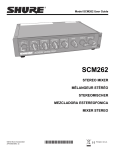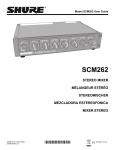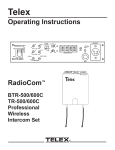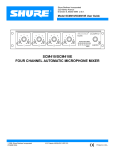Download Shure SCM268 Specifications
Transcript
Shure Brothers Incorporated 222 Hartrey Avenue Evanston IL 60202-3696 U.S.A. Shure SCM268 Mixer SCM268 Four-Channel Microphone Mixer E1998, Shure Brothers Inc. 27A8606 (RD) Printed in U.S.A. SHURE SCM268 DESCRIPTION The Shure Model SCM268 is a transformer-balanced, fourchannel microphone mixer. Its simple, compact design delivers superior performance and exceptional sound quality with low noise and a flat frequency response. Versatile in all types of applications, the SCM268 integrates transformer-balanced XLR inputs, a switchable microphone/line level transformer-balanced XLR output, phono jack inputs and S S S S output, phantom power, and an auxiliary input channel. It can function as a primary or add-on mixer for sound reinforcement, recording, broadcast, or audio-visual presentation systems. With the supplied hardware, the mixer’s half-rack chassis mounts securely in single or dual rackmount installations. For fixed installations, the SCM268 can be fastened on or below a shelf, counter, or tabletop. FEATURES S S S Four transformer-balanced microphone inputs Transformer-balanced output—switchable mic/line level Five –10 dB line-level inputs Six-segment LED output level meter Built-in 12-volt phantom power Internal power transformer Built-in low-cut filter on microphone inputs (below 80 Hz) FRONT PANEL Ê Ë Ì Í Ê Ë Gain Controls (1–4). Adjusts gain for microphone level inputs and auxiliary level inputs 1–4. Auxiliary Channel Gain Control (AUX IN). Adjusts the auxiliary channel input gain. Output Meter. LED meter indicates peak output signal level. Î Master Gain Control (MASTER). Adjusts overall output level. Ì Í Î Power Indicator (POWER). This LED illuminates when the unit is plugged in and receiving power. NOTE: The SCM268 does not have a power switch. To turn the unit off, unplug the power cord or use an external power strip with a switch. However, it can remain plugged in as it uses very little power when idle. REAR PANEL Ê Ë Ì Í Ê Ë Ì ÍÏ Î Ð Power Connector. Accepts 100–120 Vac (SCM268) or 220–240 Vac (SCM268E). Output Connector (MIC/LINE OUT). Transformer-balanced XLR output connector. Switchable between line and microphone level. Output Level Switch (MIC/LINE OUT). Recessed switch changes the signal level of the XLR output connector: In = Microphone Level Out = Line Level Auxiliary Output Connector (AUX OUT). Phono jack feeds consumer-level audio equipment. Not affected by MIC/LINE switch. Î Ï Ð Ñ English – 1 Ñ Auxiliary Level Inputs (AUX LEVEL INPUTS, 1–4). Phono jacks connect to consumer-level audio sources. Auxiliary Input Channel (AUX IN). A dedicated auxiliarylevel input for the auxiliary channel. Phantom Power Switch (12V PHANTOM). Recessed switch turns on phantom power for microphone inputs 1–4. Microphone Level Inputs (MIC LEVEL INPUTS). Transformer-balanced, microphone-level XLR inputs. Input Gain GAIN CONTROL Output Gain The gain control knobs 1–4, located on the front panel, adjust the gain for both microphone and auxiliary-level inputs of channels 1–4 (see Figure 1). For example, the channel 1 gain control is used for both the channel 1 microphone input (MIC LEVEL INPUT 1) and the channel 1 auxiliary level input (AUX LEVEL INPUT 1). The auxiliary gain control knob (AUX IN) affects only the auxiliary input (AUX IN). The master output gain control knob (MASTER) adjusts gain to both the XLR balanced output (MIC/LINE LEVEL) and the auxiliary level output (AUX LEVEL). Auxiliary Channel Channel 3 Channel 1 Channel 2 Channel 4 Master Output GAIN CONTROL Figure 1 OUTPUT LEVEL METER The six LEDs on the front panel labeled OUTPUT LEVEL METER illuminate to reflect the peak level of the mixed output signal from the SCM268 (in reference to balanced line output) in dBu (0 dBu = 0.775 V). GREEN—Nominal Use the master gain control (MASTER) to adjust peak levels, as indicated by the LEDs. The red LED illuminates when the output is 2 dB below clipping. RED—Clip Peak Level in dBu PHANTOM POWER When the phantom power switch on the back panel is on (12V PHANTOM—ON), the SCM268 provides 12 V of phantom power to each XLR microphone input. The switch is recessed to prevent accidental engagement. Most condenser microphones require phantom power. Use it when connecting these types of microphones to the SCM268. NOTE: Phantom power does not affect the operation of balanced dynamic microphones. With phantom power on, they can be connected to the SCM268 in combination with condenser microphones that do use it. OFF ON LINE MIC Phantom Power Switch OUTPUT LEVEL SWITCH The output level switch on the back panel (MIC/LINE OUT) sets the level of the balanced XLR output. When set to MIC, it reduces the output by about 50 dB. Set the switch so that the output level matches the input level of the device to which you are connecting the SCM268. The switch is recessed to prevent accidental engagement. NOTE: The output level switch does not affect the auxiliary output (AUX OUT) level. English – 2 Output Level Switch CONNECTIONS The following diagram illustrates a few of the many types of connections possible with the SCM268. Note that nothing is connected to the channel 4 microphone input (MIC LEVEL INPUT 4). This is because channel 4 is being used for the consumer-level equipment connected to the channel 4 auxiliary level input (AUX LEVEL INPUT 4). Connecting both auxiliary level and microphone level inputs to a single channel is not recommended because the SCM268 would not be able to independently mix the two sources. AUX IN CHANNEL 4 CHANNEL 3 CONSUMER-LEVEL EQUIPMENT CONSUMER-LEVEL EQUIPMENT DYNAMIC MICROPHONE CHANNEL 2 CHANNEL 1 CONDENSER MICROPHONE DYNAMIC MICROPHONE CD PLAYER OR AM/FM RECEIVER OR VCR TAPE DECK POWER SUPPLY ÁÁÁ Á ÁÁ Á POWER AMPLIFIER LOUDSPEAKERS ÁÁ Á OR ÂÂÂ ÂÂÂ ÂÂÂ ÂÂÂ ÂÂÂ ÂÂÂ ÂÂÂ ÂÂÂ LINE OUT OR 70 V P.A. English – 3 OR AUX OUT INSTALLATION Supplied Hardware S S S S S S S S 4 rubber feet. For stand-alone installation. 1 rackmount bracket, long. For half-rack (single unit) installations. 1 rackmount bracket, short. For half-rack (single) or dualmount installations. 2 straddle brackets. For dual-mount or fixed installations. 12 bracket screws, 1/4 in. (6 mm). For securing the brackets to the chassis. 4 rackmount screws, 1 in. (2.5 cm). For mounting the unit in a rack. 4 plastic washers. For use with the supplied rackmount screws. 2. After attaching the brackets, mount the unit in an equipment rack using the supplied rackmount screws and plastic washers. 4 wood screws, 1/2 in. (1.25 cm). For fixed installations. Stand-Alone Installation Adhere the four (4) supplied rubber feet to the bottom of the unit at each corner. This will keep it from sliding and protect the table surface. Bracket Screw Rackmount Screw Wood Screw Rackmount Installation The SCM268 can be mounted as a single unit or dualmounted with either another SCM268 or another Shure half-rack unit such as the SCM262 or DFR11EQ. 1. Attach the rackmount brackets using one of the following methods: Single unit (half-rack) installation: Attach the short and long rackmount brackets to the SCM268 with eight (8) of the supplied bracket screws. Fixed Installation To permanently affix the SCM262 above or below a table, shelf, or counter top, use the following steps: 3. Fasten the straddle brackets to the recessed edges of the chassis using four (4) bracket screws. Top mount: Fasten the straddle brackets to on the bottom of the unit Hanging mount: Fasten the straddle brackets to the top of the unit. 4. Fasten the straddle brackets to the surface using the four (4) supplied wood screws. TOP MOUNT Dual-mounted installation: a) Connect the two units together side-by-side using two (2) straddle brackets. The brackets should straddle the recessed edges on on the top and bottom of each chassis. Fasten them using eight (8) bracket screws. NOTE: Be sure to use both straddle brackets—one on the top and one on the bottom. b) Attach the short rackmount brackets to the outsides of the combined units with eight (8) of the bracket screws. English – 4 HANGING MOUNT INTERNAL MODIFICATIONS The following table lists the low-cut frequency corners for some of the most common capacitor values: WARNING! Voltages in this equipment are hazardous to life. No user-serviceable parts inside. Refer all servicing to qualified service personnel. Capacitor Value (mF) Low-Cut Frequency Corner (Hz) .033 803 .047 564 .068 390 Disassembly To access the printed circuit board (pc board) for internal modifications, use the following steps: 1. Unplug the power cord. 2. Remove the knobs and retainer nuts from the front panel (See Figure 2). KNOB ASSEMBLY Figure 2 .1 265 .22 120 .33 80 .47 56 .68 39 1.0 26.5 2.2 12 Phantom Power Disable 3. Remove the four screws at each corner of the back panel. 4. Remove the two screws at each bottom corner of the front panel 5. Slide the back panel and pc board out from the rear of the chassis. CAUTION: When reassembling the SCM268, DO NOT OVERTIGHTEN the knob retainer nuts. Use a minimal amount of force to secure the nut (0.6–0.8 N⋅m (5–7 in⋅lb)). Damage to the internal components will result if too much force is used. To disable phantom power for a given microphone input, remove the specified resistor as listed in the following table: Channel Remove Resistor: 1 R15 2 R25 3 R35 4 R45 Low-Cut Filter To bypass the built-in low-cut filter for a given channel, remove the specified resistor and place a 10mF to 33mF capacitor in the specified pc board location (polarity does not matter). Refer to the following table: Line Pad To insert a 50 dB line pad for a given microphone input, remove the specified resistor and short the solder points at the specified pc board locations. Refer to the following table: Channel Remove Resistor from: Place 10mF to 33mF Capacitor in: Channel Remove Resistors: Short Solder Points: 1 R18 X17 1 R12, R13 X11 and X14 2 R28 X27 2 R22, R23 X21 and X24 3 R38 X37 3 R32, R33 X31 and X34 4 R48 X47 4 R42, R43 X41 and X44 To select a particular corner frequency for the low cut filter, remove the R18, R28, R38, or R48 resistor for a given channel as specified above. Then, in the corresponding pc board location (X17, X27, X37, or X47), place a capacitor of the specified value (polarity does not matter). Refer to the following formula for selecting the correct capacitor value for the desired corner frequency. C= 26.5 F where: C = value of capacitor in mF F = corner frequency (–3 bB) for low-cut filter in Hz English – 5 SPECIFICATIONS Measurement Conditions (unless otherwise specified): Line voltage 120 Vac, 60 Hz (SCM268) or 230 Vac, 50 Hz (SCM268E); full gain; 1 kHz, one channel activated; source impedances: Mic 150 Ω, Aux Level 150 Ω; terminations: Line 600 Ω, Mic 600 Ω, Aux Out 10 kΩ. 12 V phantom power off. Frequency Response (Ref 1 kHz, controls centered) Microphone Inputs: 150 Hz to 20 Khz ±2 dB (built-in 80Hz low-cut) Auxiliary Inputs: 20 Hz to 20 kHz ±2 dB Low-Cut Filter (Microphone inputs only) 3dB down at 80 Hz, 6 dB/octave Gain (typical, controls full clockwise) Inp t Input Low-impedance mic (150 Ω) Aux Level Mic 38 dB Output Line 76 dB Aux Out 65 dB 3 dB 40 dB 29 dB Inputs Input Mic Aux Level Impedance Actual Designed (typical) for use with 19-600 Ω ≤2 kΩ 1.2 kΩ 21 kΩ Input Clipping Level –5 dBV >28 dBV Outputs Output Mic Line Aux Out Impedance Actual Designed (typical) for use with low-Z inputs >600 Ω >2 kΩ 0.2 Ω 72 Ω 870 Ω Output Clipping Level –21 dBV +18 dBV +7 dBV Total Harmonic Distortion <0.25% at +4 dBu output level (through 22 Hz-22 kHz filter; Input 1 and Master centered, all other controls full counterclockwise) Hum and Noise Equivalent Input Hum and Noise . . . . . . . . . . . . . . . . –124 dBV (150 Ω source; through 22 Hz - 22 kHz filter) Output Hum and Noise (through 22 Hz to 22 kHz filter; channel controls full counterclockwise) Master full counterclockwise . . . . . . . . . . . . . . . . . . . . . –92 dBV Master full clockwise . . . . . . . . . . . . . . . . . . . . . . . . . . . –70 dBV Common Mode Rejection >80 dB at 1 kHz Polarity All inputs to all outputs are non-inverting Overload and Shorting Protection Shorting outputs, even for prolonged periods, causes no damage. Microphone inputs are not damaged by signals up to +10 dBV; Auxiliary inputs by signals up to +36 dBV Phantom Power 12 Vdc open-circuit through 340Ω series resistance Operating Voltage SCM268: 100–120 Vac rated nominal, 50/60 Hz, 60 mA SCM268E: 220–240 Vac rated nominal, 50/60 Hz, 30 mA Temperature Range Operating . . . . . . . . . . . . . . . . . . . –7° to 49° C (20° to 120° F) Storage . . . . . . . . . . . . . . . . . . . . –29° to 74° C (–20° to 165° F) Overall Dimensions 44 mm H x 218 mm W x 162 mm D (1.72 x 8.60 x 6.37 inches) Net Weight 1.20 Kg (2 lbs, 11 oz) Certifications SCM268: UL & cUL Listed by Underwriters Laboratories, Inc. SCM268E: Conforms to European Union directives, eligible to bear CE marking; VDE GS-Certified to EN 60 065; meets European Union EMC Immunity Requirements (EN 50 082–1, 1992) Replacement Parts Knob, Master (blue) . . . . . . . . . . . . . . . . . . . . . . . . . . . . . 95B8752 Knob, Channel Gain (white) . . . . . . . . . . . . . . . . . . . . . . 95A8752 Line (Power) Cords: SCM268: 100–120 Vac (US/Canada) . . . . . . . . . . . 95A8762 SCM268E: 220–240 Vac (EU) . . . . . . . . . . . . . . . . . 95A8778 Fuse, SCM268 (5x20 mm, 250V, 80mA, slow-blow) . . 80A730 Fuse, SCM268E (5x20 mm, 250V, 40mA, slow-blow) . 80J258 Optional Accessories Line (Power) Cord, 230–240 Vac (UK) . . . . . . . . . . . . . 95A8713 English – 6







